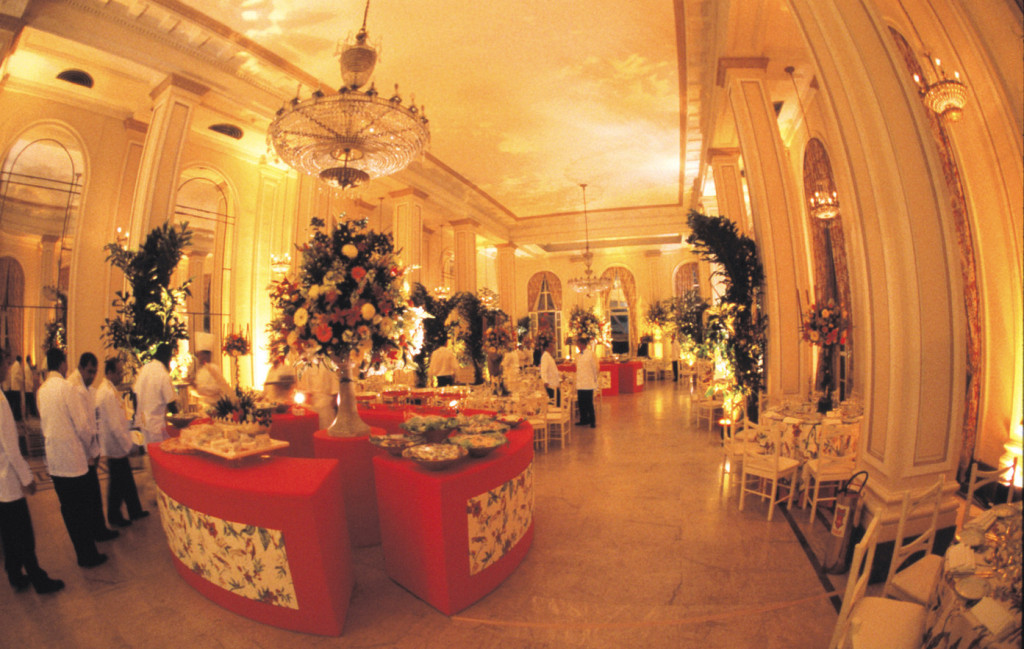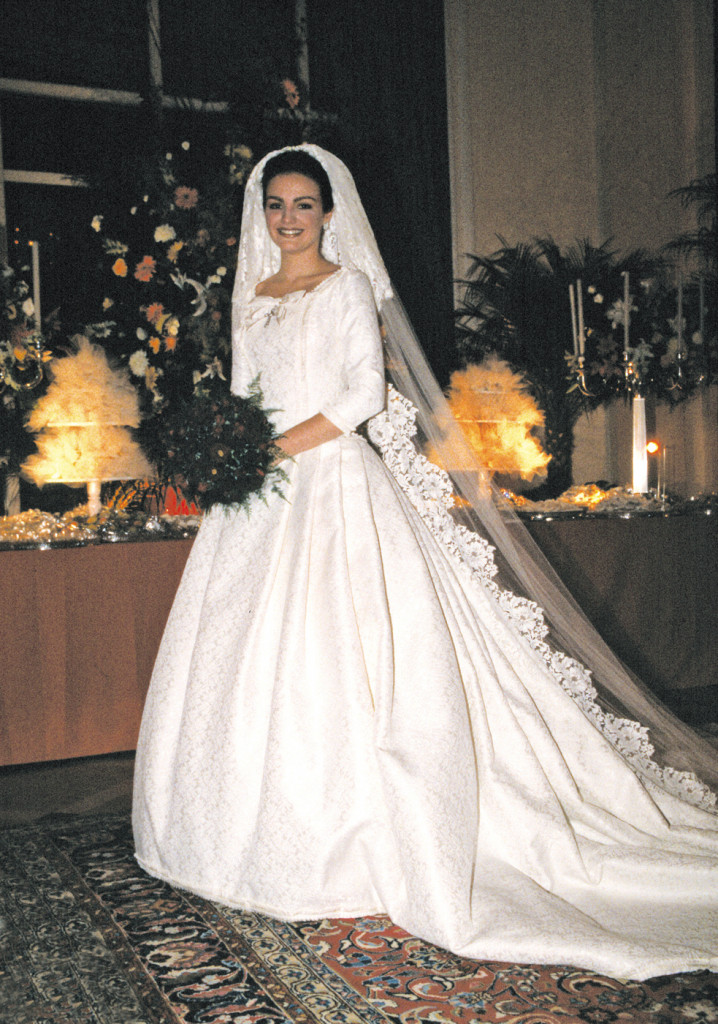Elaborate fashions and traditional dishes, plus age-old rituals of commitment are part of the Latin wedding tradition.
Traditions | The Latin Wedding

An Abundance of Ribbons
“A typical Mexican wedding includes white ribbons,” says Adriana Arroyo of the Hilton Hotel Mexico City Airport, who tells us the ribbons are almost everywhere. “They decorate the newlywed’s car, they’re combined with flowers and put on the upper façade of the church, they’re on the wedding cake, and they’re used to tie wedding gifts. The bride also ties her small thank-you wedding souvenirs with white ribbons.”
During the marriage vows, another white ribbon, called a “lazo,” is also symbolically wrapped around the necks or shoulders of the couple. “It represents their joining,” says Adriana.
The lazo might instead be a large rosary, and it confirms the union of the couple and their commitment to always be together. “They wear the lazo throughout the ceremony, after which it is removed and given to the bride as a keepsake.”
The wedding is a time for family and friends, and all have roles to play, starting with the parents, who give their blessing to their son or daughter before leaving the house for the church.
The new couple also is helped financially by their godparents, who act as “padrinos,” or sponsors of the wedding. “They’re mentors to the bride and groom throughout their engagement and even after they are married.”
The bride and groom typically honor their padrinos with a place in the wedding program, and during the ceremony the padrinos may also present the couple with a rosary or a bible.
“When the bride and groom exchange rings, each ring has the name of the other inscribed inside, plus the date of their marriage,” explains Adriana. “Sometimes the bride will get a traditional ring from her family or his, or it might even be a Catholic medal.”
A Mexican groom often will give his wife a wedding present of 13 gold coins (arras). Representing Christ and his 12 apostles, they are blessed by the priest during the ceremony. The coins also symbolize his commitment to support his new wife. By accepting the coins, she is assuring him of her love and devotion to look after him and their possessions.
Shannon Fluet evokes classic Latin elegance before a dramatic painting in a gown by Emmanuelle. Her bouquets are by Mundo Floral, with Ariston Flowers
Wedding Day Fashions
For good luck, the bride typically wears something old, something used, and something received as a gift. “This is like the American tradition of ‘something old, something new, something borrowed, something blue,’ ” says Adriana. “The individual items might be a jewel, lingerie, or even a garter. But the bride should not wear pearls, because they represent sadness and teardrops.”
Wearing her mother’s or grandmother’s wedding dress is a sign of respect for family tradition. To help bring food, money, and passion into their marriage, the bride may sew a yellow, a blue, and a red ribbon onto her lingerie.
Some Latin brides wear a mantilla veil, while others might wear a slim dress with a bolero jacket or even a Flamenco-style dress with ruffles at the hem. The groom may wear a matador-styled outfit, a bolero jacket with tight fitting pants, or a Mexican wedding shirt with loose, drawstring pants.
The Reception
“When the ceremony is finished,” says Adriana, “every guest takes a picture with the couple outside the church!”
At the wedding reception, the bridal couple dances to the first melody in the ballroom. “This piece is very important for the couple,” Adriana tells us, “since they have chosen it together as their song.”
During this first dance, all the guests join hands and form a heart shape around the newly married couple. The first dance is followed by salsa music or other popular songs as everyone joins the fun and the party begins.
The “Money Dance,” where male guests “pay” to dance with the bride, is very popular. “You want the guests to be generous when ‘paying,’ since the money is for the newlyweds on their honeymoon and for setting up their household.”
Traditional Mexican foods at the reception often include spicy rice, beans, and tortillas, served with sangria, which is made from red wine mixed with brandy, sugar, fruit juice, and soda water. The Mexican wedding cake is usually a fruit cake that’s been soaked in rum.
A paper mache piñata might also be hung from the ceiling. “It’s shaped like a heart and filled with candy. The children swat at it and when they break it, everyone shares the candy.
“After dinner the couple stops by each table to thank each guest and to give them a gift,” and so the night ends with gifts received and presented.
Preparing for the wedding reception
Tradition!
One bride from a very traditional Mexican family was recently featured in our pages here at Manhattan Bride. She tells us that in her tradition, the groom asks to meet with the father of the bride and brings a “presente,” or gift, with baskets of Mexican bread, fruits, and liquor. Her groom asked her parents for her hand in marriage, for example, and got down on one knee in front of her family.
Traditonally, the ceremony was held at the bride’s house. The groom would ride a horse to the bride’s house and after the ceremony he’d take his wife to his parents’ house.
In keeping with this traditon, our couple had a ceremony at the bride’s parent’s home, where their mariachi band played “Las Mañanitas.” In the Mexican village where her parents are from, it’s traditional for the bride to walk to the church with her family with the mariachi playing in the background, which they did.
The ceremony included blessings given at the door, the presence of their godparents for the mass, the rings, the arras, and the lazo, wrapped around the around the couple to symbolize their unity.
“As soon as we were introduced, guests joined in a traditional dance called ‘Las Flores,’ dancing back and forth with bamboo baskets filled with flower petals, and at the end of the song all the flower petals were thrown onto us, to wish us good luck.”
Love & Marriage, Rio-Style
“Here in Rio,” says Alex Lopez of the Copacabana Palace, “we date at beaches, parks, movie theaters, and nightclubs. We give flowers and chocolates. Almost every time I go to my fiancé’s house, I buy her chocolate!”
Along with another man we met that day, Alex is wearing a gold ring on his right hand, and Alex tells us that his fiancée is doing the same.
Claudia Fialho, also of the Copacabana Palace, explains the practice. “When a couple gets engaged in Brazil, the man wears a gold band on his right ring finger, and the woman wears one on her right ring finger,” she tells us. “When you get married, you pass it to your left hand. The gold engagement band means the couple has an agreement with their families and with society.
The bride wore a traditional mantilla veil as she prepared to welcome 1300 guests to her wedding at Rio’s famed Copacabana Palace.
“One week before the wedding,” Claudia continues, “the bride has a tea party at her house and her friends bring gifts for the kitchen. We call it ‘Casserole Tea.’ After the party the guests take home a kind of biscuit held together with milk marmalade. The biscuits are called ‘well-married.’ ”
“Sometimes,” adds Andrea Martin of the Copacabana Palace, “the bride sews small pieces of paper with the names of her friends who want to get married into the hem of her dress.”
“The bridesmaids are small children from the family,” says Claudia. “They gather in front of the bride with the engagement rings. In Brazil, we never have individual friends of the bride in the ceremony. Instead, at the altar there are couples who bless them. They can be close friends or relatives.”
Like in the Mexican traditon, the bride’s ring should have the name of the groom and his would have her name.
“After the ceremony,” says Andrea, “the bride and groom go to their room together. She fixes her makeup and then they go back to the party and cut the cake. That’s the first thing they do. Then they dance the waltz.”
An old Brazilian custom has the bride placing her shoes in the middle of the dance floor, where the guests are to place presents for the newlyweds and their future.
At the wedding reception, it is common to see everyone enjoying a caipirinha, Brazil’s most popular drink, which is made from alcohol distilled from sugarcane and mixed with sugar and limes.
A popular reception dish is called “Feijoada,” a mix of black beans and pork. For dessert, Brazilian “casadinhos” or “well-married” cookies given out at the bride’s tea party, may also be served again.
Over 1000 Guests
“Recently we held a wedding with 1,300 people,” Andrea continues. “We had them in all the banquet rooms, in the balcony, and in the main room. In each room we had a buffet and in two or three rooms we had an open bar. In the main room we had coffee and sweets.”
The decorator carried through the bride’s theme of “apricot,” using touches of the color to decorate each room. To accommodate the couple’s wide range of musical tastes, the band was chosen because of its ability to range from Sinatra to the samba to the Rolling Stones.
“Buffets are much easier than trying to serve that many people. We had one waiter for each 15-20 people and five maitre d’s. We used walkie-talkies to communicate!
“Weddings in Brazil usually have 300 to 400 guests. Here it is a tradition to have a big wedding because it’s as much for the parents to invite their friends and family as it is for the bride and groom to celebrate their union.”



